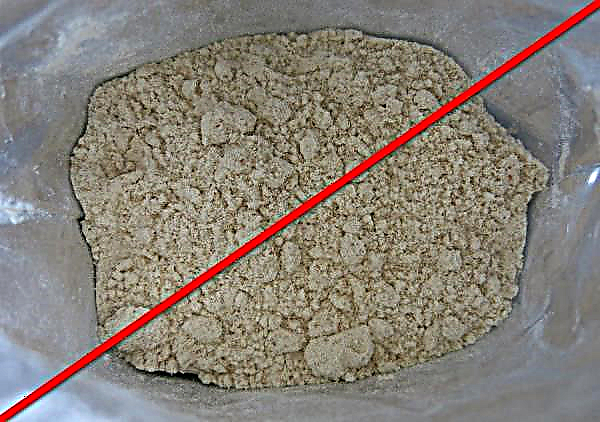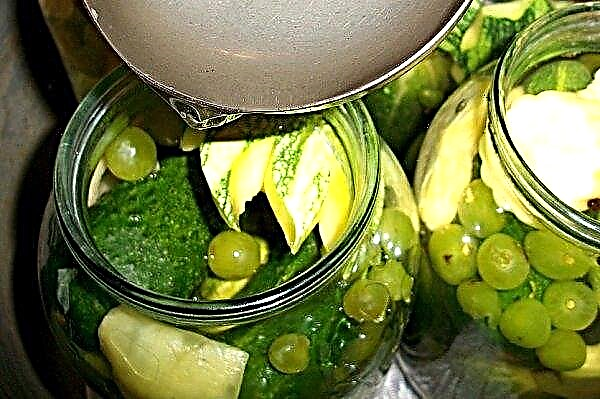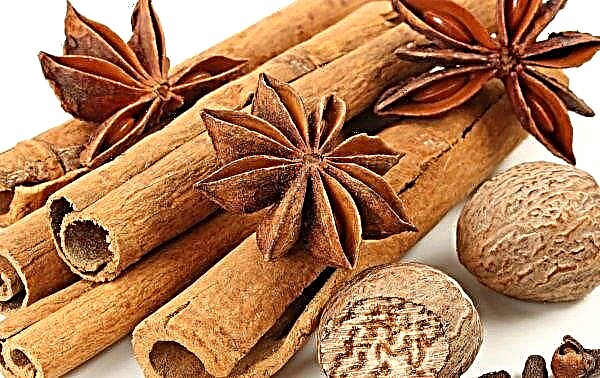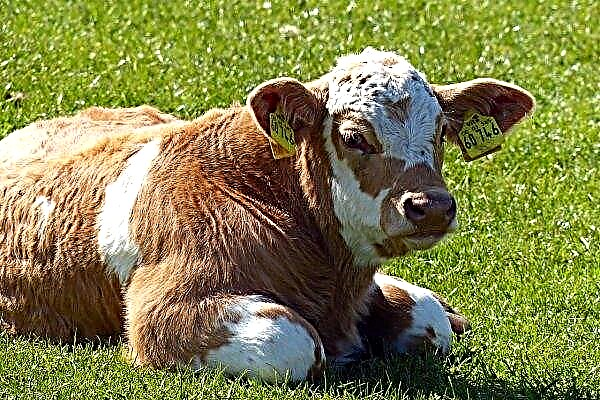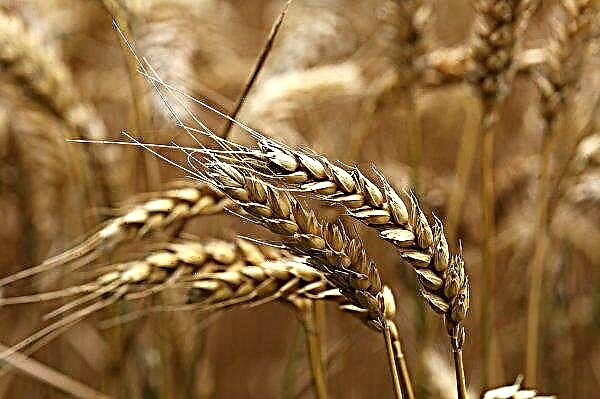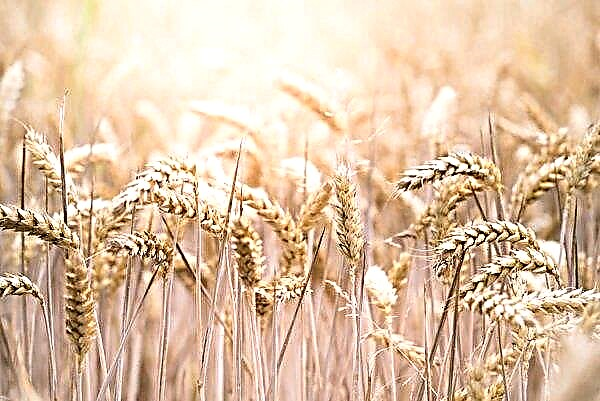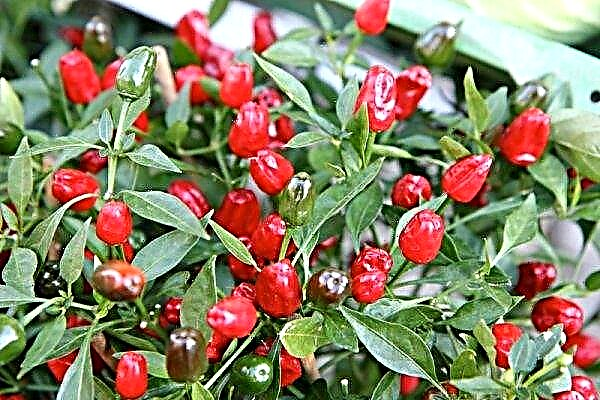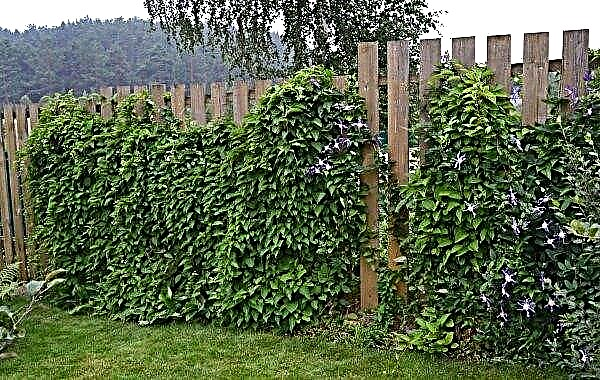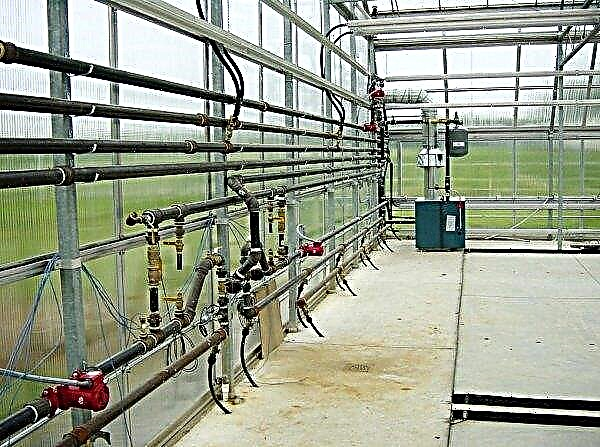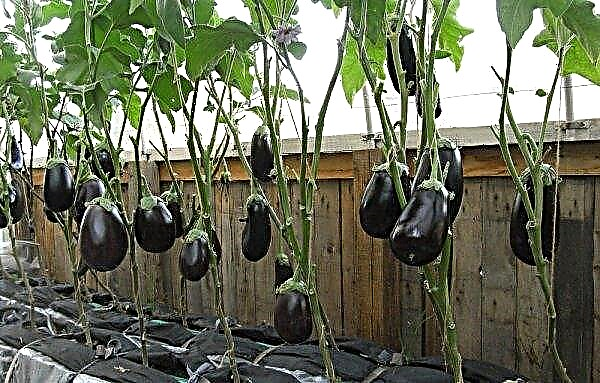When planting garlic in their beds, very few gardeners think about its variety. Meanwhile, not only taste characteristics, useful properties and crop productivity, but also the technology of its cultivation depend on this. This review contains all the useful information about cultivating a variety of garlic with the delicate name Lyubasha.
Grade description
Garlic Lyubasha is a large winter variety of Ukrainian selection. It is distinguished by the following characteristics:
- the height of the plant, taking into account the arrow, is on average 100-120 cm, although under favorable conditions it can reach 1.5 m;
- leaf length of about 50 cm, width 1.5–2.5 cm, color - dark green;
- the arrangement of leaves is semi-vertical, the structure is dense, on the surface there is an average thickness of the wax layer, each sheet has a slightly curved shape;
- the heads are large, have a rounded, slightly flattened shape, a minimum weight of 60 g, a maximum weight of 350 g, an average of 100-120 g;
- the number of teeth in the head ranges from 4 to 9, but usually averages 7;
- the average weight of one tooth is 15–20 g;
- the color of the cloves is white with a delicate shade of pink or cream;
- the skin itself is painted with purple stripes on a common white background;
- the taste of the teeth is pleasant, bright, sharp, the aroma is very saturated;
- the purpose of the variety is universal: garlic is equally well suited for making sauces, hot dishes, homemade spins, dressing salads and pickling by any means;
- productivity - according to various sources and depending on growing conditions, can vary from 3.5 to 20 tons per 1 ha.
Photo gallery
The chemical composition of Lyubasha is characterized by a high content of vitamin C (up to 34%). As for allicin, a natural antibiotic and the main biologically active substance, which is valued in garlic, in Lyubasha its amount is 0.3%.
Did you know? The etymology of the word “garlic” is interesting. It turns out that it came from the Proto-Slavic česti, meaning "to scratch" or "tear." Thus, the name focuses on the description of the plant bulb, as if torn, split into several parts.
Advantages and disadvantages
- The unconditional pluses of the variety are usually:
- large-fruited and, accordingly, high productivity;
- resistance to frost and spring cooling;
- high genetic strength;
- low requirements for humidity and regular watering;
- high immunity to most fungal infections, especially fusariosis, low susceptibility to pest attacks;
- early maturity (about 95 days from the moment of emergence of shoots, which usually means the beginning of harvesting from the third decade of June)
- high commercial quality (thanks to large heads of the same shape, the variety is often grown for subsequent sale);
- excellent taste and bright aroma, allowing you to use not only the bulbs, but also the leaves of the plant;
- rich vitamin and mineral composition, providing numerous beneficial properties (the variety has no equal in the content of essential oils);
- universal purpose of bulbs;
- long shelf life (in favorable conditions, the crop can maintain external properties, taste and chemical composition for 10-11 months from the date of collection).
- Lyubasha’s shortcomings are rarely talked about. For example, this list sometimes includes:
- relatively low content of allicin (there are varieties of garlic in which the amount of this substance reaches 0.74%, that is, 2 times more than that of Lyubasha);
- firing arrows and the need for their timely removal;
- the need for mulching the beds for the winter, especially in regions with harsh climates.
However, it should be noted that the last 2 features from the above list are typical for all types of winter garlic, but Lyubasha garlic, even with arrows not removed on time, still forms large heads.
The rules for planting garlic
Winter garlic can be planted in three ways - with cloves, seeds and the so-called single-tooth bulb (obtained from air seeds next year). Usually summer residents and even professional farmers use the first version of planting material, it is considered the most convenient and familiar.
The timing
Since this is a winter variety, it should be planted in the fall. The time period when this is best done depends on many factors, both objective (climatic zone, current weather conditions) and subjective (personal preferences of the gardener).
Important! If you plant too early, the clove can germinate before the onset of cold weather, after which the embryo will inevitably die with the advent of winter. However, an overly late planting is also unacceptable: in frozen ground, garlic will not be able to adapt and will also disappear.
Usually they say that it is best to plant garlic in such a way that before the onset of frost it can spend about 2 weeks in the ground: if we are talking about the middle lane, this moment comes from about the third decade of September to the first decade of October, in more southern areas , in particular, in Ukraine - it is better to wait until November.
However, in reality, the timing can be adjusted by changing the landing depth. So, the classic landing under the winter in the above terms involves laying a clove to a shallow depth (3-5 cm). However, if you dig a little tooth deeper, onto the bayonet of a shovel (10-15 cm), you can land without fear in early September and until mid-October. Many gardeners also prefer deep planting because this way the garlic roots better, and the likelihood of it freezing in the case of a particularly harsh winter is much lower. In regions with a traditionally mild climate, deep-planted garlic can not be mulched, which also greatly facilitates the work of the summer resident.
Choosing a place to land
Garlic is not a demanding crop, but it needs a lot of light to get a good harvest. It is best to place the bed from north to south so that the sun's rays illuminate all the plants equally well. You can’t place garlic in a lowland; if water stagnates in the soil, the roots of the plant will rot and the crop will hurt, which will negatively affect the quantity and quality of the crop.
The composition of the soil for garlic is not critical, however, it is desirable that the soil is light, fertile and has a normal or slightly acidic reaction. The minimum pH in the soil is 6.5. If this indicator is less, lime must be added to the earth in advance.
Did you know? If you plant garlic in a common bed with strawberries, the berries will not hurt and will be attacked by pests, and the bulbs will form much larger.
Do not neglect such an agricultural technique as crop rotation. The table shows the good and bad predecessors for garlic:
| Good predecessors | Bad predecessors |
| Greenery | Tomatoes |
| Zucchini | Potatoes |
| Squash | Sweet pepper |
| Cucumbers | Bitter pepper |
| Pumpkin | Eggplant |
| Watermelon | Bow |
| Melon | Carrot |
| Beans | |
| Peas | |
| Lentils | |
| Cabbage (early) |
When evaluating the precursor, it should be borne in mind that the root system of garlic is close to the surface. Therefore, deep-root crops usually do not deplete the soil for garlic and do not interfere with its normal development. Experts do not recommend planting garlic in one place for more than 2 years in a row. During this period, the stem nematode, the main enemy of culture, manages to settle in the garden and begins to affect crops more and more.
Experts do not recommend planting garlic in one place for more than 2 years in a row. During this period, the stem nematode, the main enemy of culture, manages to settle in the garden and begins to affect crops more and more.
Bed preparation
You need to prepare the garlic bed from the end of August. Start by carefully removing weeds. It is advisable to raise the cleaned and leveled bed so that it rises above the general ground level by 20–25 cm.
Then fertilizers are applied. Based on 1 m² of land, it is necessary to lay such a set of organic and mineral additives in it:
- humus - 10 kg;
- chalk - 1 glass;
- wood ash - 2 glasses;
- potassium sulfate - 2 tbsp. l .;
- superphosphate - 1 tbsp. l
Important! Fertilizing the garlic bed with manure is strongly discouraged. From such organics, the plant gives a very abundant tops, and onions, on the contrary, form soft and loose. Ptherefore nAfter the introduction of manure, no less than a year must pass before planting.
All of these components are distributed evenly on the surface of the future bed, after which the earth is carefully dug up at least on the bayonet of the shovel and plentifully watered with copper sulfate solution (1 tbsp. Per bucket of water, enough to process 2 m² of beds). Top soil should be covered with a film. All the time remaining before planting the earth should sag. If autumn does not pamper with rains, the earth needs to be watered several times to accelerate shrinkage. Planting garlic in the freshly dug up soil leads to the fact that under the influence of rain and melting snow, the teeth go deep into the ground, after which they can not germinate for a long time. Productivity in this case is inevitable.
All the time remaining before planting the earth should sag. If autumn does not pamper with rains, the earth needs to be watered several times to accelerate shrinkage. Planting garlic in the freshly dug up soil leads to the fact that under the influence of rain and melting snow, the teeth go deep into the ground, after which they can not germinate for a long time. Productivity in this case is inevitable.
The last preparation is carried out the day before planting. The bed is abundantly watered with a urea solution so that about 10–20 g of the substance falls on 1 m² of soil. You can simply sprinkle urea on the surface of the earth and then pour water.
Selection and preparation of planting material
For planting Lyubasha, you can use the teeth obtained from the last harvest. However, it is important to know one caveat. Garlic propagated by cloves degenerates very quickly, and if the first harvest pleased the summer resident with its abundance and quality, each subsequent crop will gradually become worse - the heads are smaller, the number of cloves in them decreases, the taste of the bulb becomes less and less bright. It is for this reason that progressive agriculture suggests alternative methods of propagation of garlic. It is not necessary to practice them in one's own country house, however, it is still better to purchase planting material, and use proven sources for these purposes.
Did you know? Chinese scientists conducted an experiment involving 5 thousand patients with an increased risk of developing stomach cancer. For 5 years, half of the participants received a drug made from a mixture of garlic and selenium, the other was given a placebo. The results showed a decrease in the incidence of gastric cancer with garlic by 52%, and all other malignant neoplasms - by a third.
Preparatory work with planting material involves the following actions:
- The head is disassembled into separate teeth.
- Each tooth is carefully inspected. The smallest, sick and damaged are discarded (they can be used to prepare various dishes).
- The teeth selected for planting must be decontaminated. To do this, they are placed for a day in a weak solution of potassium permanganate or vitriol (in the first case, 1 g of the substance is taken per 1 liter of water, in the second - 10 g).

Landing process
The planting process begins with digging holes. For large garlic, the minimum distance between them should be 10 cm with a row spacing of 30-40 cm. The depth of the hole, as was said, depends on the time of planting.
At the bottom of each well, the prepared tooth is placed with the nose up. However, efforts should not be made to push a clove into the ground; this can damage the planting material and impede the formation of roots.
From above, you can simply fill the hole with earth, but it is better to use well-rotted compost for this purpose. You do not need to water the garlic after planting, however, it is important that the ground is initially moist (as was said, it must be watered the day before).
Video: Planting winter garlic in the fall
Follow-up care
Caring for Lyubasha is not very difficult. There are just a few additional conditions, the observance of which guarantees the receipt of an even higher crop from this amazing variety.
Mulching for the winter
In regions with harsh winters, winter garlic beds need shelter.
Important! With a deep planting, garlic varieties with less frost resistance than Lyubasha’s resistance can well tolerate a drop in air temperature to –20 ° C, thus sheltering the crop in many cases is a reinsurance measure.
Unlike ordinary shelter, mulching the beds is not only aimed at protecting the planted teeth from freezing. Mulch, if it was used full-fledged organic matter, nourishes the soil, retains moisture in it and, importantly, prevents the active germination of weeds in the spring.
Mulch garlic using:
- hay;
- fallen leaves (oak is great);
- coniferous needles or paws;
- peat.
 The mulch layer should be thick enough - at least 10 cm. Experts even advise using different materials, for example, to lay the foliage as a lower tier, and cover it with a lot of hay on top.
The mulch layer should be thick enough - at least 10 cm. Experts even advise using different materials, for example, to lay the foliage as a lower tier, and cover it with a lot of hay on top.Watering
Water garlic should be plentiful, but only at the beginning of the growing season. Drying of culture is especially critical at the moment when the first leaves appear and the bulb begins to form. At this time, at least a bucket of water should leave for 1 m² of bed (if the weather is rainy, watering, of course, is reduced).
The sprinkling method for garlic beds is not very suitable, because it increases the risk of developing fungal infections and, in addition, requires much more significant water consumption than is actually needed for the crop. Optimal from all points of view is a drip irrigation system (it needs to be laid on the surface of the mulch layer, and not underneath it).
As the bulbs ripen, watering gradually decreases so that they stop completely before harvesting.
Important! Watering garlic, which is supposed to be left for long-term storage, should be stopped 3 weeks before harvesting. If the heads are planned to be used immediately, for example, for pickling, irrigation is turned off later, about a week before digging the bulbs.
Although Lyubasha refers to drought-tolerant varieties, ignoring the above irrigation rules leads to the fact that the crop is much less quality than you might expect. This applies not only to the size of the heads and the number of cloves in them, but also the amount of nutrients that garlic is valuable.
Fertilizer application
To increase productivity, farmers recommend feeding Lyubasha 3-4 times per season, using complex mineral compositions for these purposes. Fertilizing is carried out simultaneously with watering (it is best to dilute preparations with water, in dry form they are absorbed worse). The first feeding is carried out immediately after the first seedlings appeared on the surface of the earth. At this stage, you can use regular urea (20 g per bucket of water). If the bed is not mulled, it is useful to add organic matter, such as mullein, to mineral fertilizing.
The second feeding is carried out 2 weeks after the first. The composition of the fertilizer should include potassium, phosphorus and nitrogen. A good option is nitrofoska or nitroammofoska. In a bucket of water you need to dilute 2 tbsp. substances and use it for watering approximately 3 m² of beds.
Video: Spring feeding of winter garlic
In early June, Lyubasha should be fed phosphorus. For example, superphosphate can be used for these purposes (2 tbsp. Per bucket of water, this amount is distributed over 2 m² of soil).
If the ground before planting garlic was well prepared and fertilized, three fertilizers are enough. On depleted soil, between the first and last procedure, you can carry out not 2, but 3 top dressing with a complex potassium-nitrogen-phosphorus fertilizer.
Weeding and cultivation
Traditionally, after the snow finally leaves the garden, where garlic was planted in the fall, summer residents remove mulch from it and begin to wait for seedlings.However, as the soil warms up, weeds first appear on it. They must be carefully removed, otherwise they will constantly compete with the young culture, fighting as for nutrients in the soil. Care of the bed also involves loosening the soil, ensuring the preservation of moisture in it and preventing cracking.
Did you know? Garlic has the ability to stop the development of salmonella, E. coli, Staphylococcus aureus. Candida mushrooms, pathogens of thrush, are also sensitive to plants. A negative reaction to garlic is manifested by many viruses, in particular, causing some types of herpes, flu and parainfluenza, stomatitis, vaccinia, cytomegalovirus infection.
Modern agricultural techniques suggest a different approach to solving the problem. If you leave the mulch in the garden, Lyubasha garlic will successfully break through a thick shelter to the surface, but for most weeds such an action will not be possible. Gradually, the mulch, starting from the bottom layer, will decompose, enriching the bed with organic and humus, which is brought into the soil by earthworms brought in by food, which will also have the most favorable effect on the development of garlic. Thus, a bed permanently mulled out eliminates the summer gardener from practically all garlic care measures, except for irrigation, the intensity of which in this case, among other things, also decreases, due to better conservation of moisture in the soil.
Gradually, the mulch, starting from the bottom layer, will decompose, enriching the bed with organic and humus, which is brought into the soil by earthworms brought in by food, which will also have the most favorable effect on the development of garlic. Thus, a bed permanently mulled out eliminates the summer gardener from practically all garlic care measures, except for irrigation, the intensity of which in this case, among other things, also decreases, due to better conservation of moisture in the soil.
Harvesting and storage
When the leaves of the garlic begin to turn yellow, this indicates that the bulbs are ripe, and you can harvest. In Lyubasha, this moment occurs in late June or early July, depending on the climate.
After digging out the heads from them, you need to carefully shake off the ground and place them in a place protected from sunlight for several days, so that the bulbs completely dry out.
In order to keep the heads within the prescribed 10-11 months, there are several ways:
- Arrange the bulbs in sterilized jars with tight-fitting lids or in linen bags previously soaked in a saturated solution of sodium chloride and dried, and hide in a refrigerator in a container for storing vegetables.
- Put in cardboard boxes and sprinkle with plenty of flour, coarse salt or onion husks.
- Pack in glass or plastic containers and pour with vegetable oil.
- Dip in molten wax or paraffin.
- Braid or lay in nets (nylon stockings) and store on a closed balcony.
 Whatever storage method is chosen, it is recommended to remove the top layer of the husk from the bulb, on which the remains of the earth have accumulated, and also remove the roots, but not completely, but up to 1 cm. As for the stem, it can be shortened to no more than 5 cm .
Whatever storage method is chosen, it is recommended to remove the top layer of the husk from the bulb, on which the remains of the earth have accumulated, and also remove the roots, but not completely, but up to 1 cm. As for the stem, it can be shortened to no more than 5 cm .It is unlikely that one can find many varieties of popular crops in which experienced gardeners and summer residents will not find any flaw. But Ukrainian Lyubasha is a rare exception to the rule. This garlic is actively conquering the market, being equally popular among both farmers and ordinary summer residents, while all of them unanimously speak about the unconditional merits of the variety and practically do not find any shortcomings in it.

